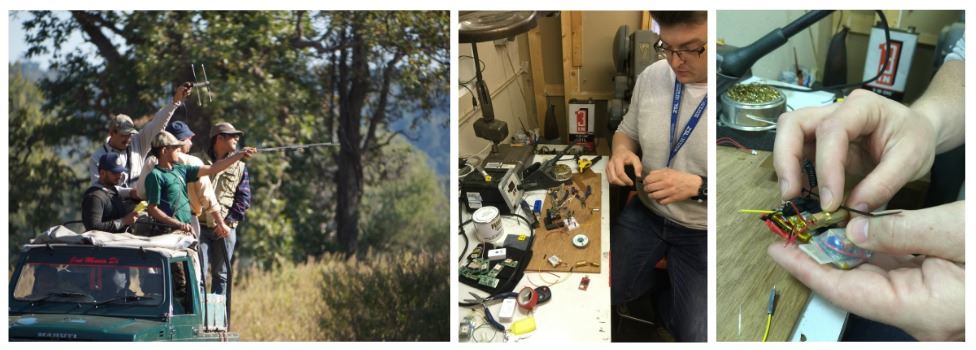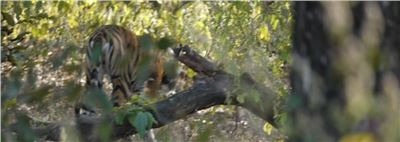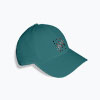The project team have spent the last several months working on a drop-off mechanism for large carnivores while continuing to trial the Mataki Tag on other species. Now in the final stages of testing, these drop-off devices will allow the team to make considerable progress with this exciting project. Next year they also plan to implement a camera trapping study in India provided the peer reviews of the proposal are favourable. We look forward to following both of these projects over the next twelve months!
Developing Mataki to aid the conservation of India’s tigers
February, 2014 saw the first ever deployment of IOZ’s open source, tracking devices on big cats. The team, working with partners in India (Wildlife Institute of India, Dehradun), were able to capture a large female Bengal tiger in Kanha National Park and fix our GPS and acceleration tracking tags – Matakai – to a pre-existing radio collar to collect high-resolution data on the movements and behaviour of this majestic animal. The tag was configured to collect data before a similar device, set up to communicate with the animal-borne tag, was used to wirelessly gather the data when within approximately 100m or less. This was achieved when the tiger was located again 3 days later resting under a tree, allowing the team to slowly approach her on elephant back and wirelessly retrieve the data.
Our Mataki tag successfully logged data continuously for three days. We were then able to successfully download 3 hours of this data remotely from elephant-back. While this is only a proportion of the data, this first field test has been invaluable in determining the best method for retrieving data in future. The recovered tracking data revealed some interesting patterns in daily activity patterns of the animal. It is hoped that with multiple success deployments of the tags on other individuals, in combination with the horizontal movements derived from the radio collar, will help us to determine behaviours such as hunting, feeding and resting of tigers within the national park and the habitats that are associated with these behaviours.
But it’s not just on tigers that we have been trialling this technique of wireless communication. Mataki tags have worked well with at the nesting sites of sea birds where the individuals spend long periods of time sufficient to allow all the data to pass between devices. Retrieving data on large carnivores from elephant back, although successful this time around, is clearly not always practical and so the team set about trying to design and develop a terrestrial ‘pop-off’ device.
The pop-off would be a mechanism to carry the tag for a predetermined time or until a remote switch is fired, that enables the tag to fall off the animal allowing us to collect it and directly obtain all of the logged data. Not as easy as it sounds when you factor in the additional weight, battery power needed, the fact that it will require moving parts and that the whole package needs to remain waterproof and relatively hard wearing to life around a 120 kg tiger’s neck.
However, many designs later, we are now in the final stages of testing our remotely operated pop-off device that retains the ethos of Mataki in that it will be low cost, light weight and open source, allowing conservationists to tailor the mechanism to their specific needs.
Testing within the Institute of Zoology has demonstrated the utility of the device that relies on a powerful, yet noiseless, pin breaking through a tie that is attached the tag to the tiger’s collar under tension, allowing it to fall away as the tension is released. The mechanism is fully enclosed and does not raise any welfare issues in addition to those relating to the collaring of the animal.
With these trials in their latter stages, the team is set to deploy the new, drop-off capable tags during the next field trip to India. We have plans to continue this work in Corbett National Park as part of a study focused on movements in and around protected areas being conducted by our colleague Dr Jhala of the Wildlife Institute of India.

Photo captions: Dr Jhala and team locating tigress for elephant
tracking, In the lab working on the pop-off, Pop-off device.
Banner image: Brief glimpse of collard tigress.
Products list
Front mesh baseball cap with signature logo12341234
Jerome first appeared on the scene on 11 April 1970, and continues to make his mark.
Front mesh baseball cap with signature logo12341234
Jerome first appeared on the scene on 11 April 1970, and continues to make his mark.
Herschel backpack in dark blue12341234
The Front Trefoil first appeared on the scene in 1972, and it continues to make its mark.
Herschel backpack in dark blue12341234
The Front Trefoil first appeared on the scene in 1972, and it continues to make its mark.
Accessories Herschel backpack in dark blue12341234The Front Trefoil first appeared on the scene in 1972, and it continues to make its mark. | >
$56.99 |
Image
|
Description
| Property Name |
Stock
|
Price
|
|---|
Accessories Herschel backpack in dark blue1234Jerome first appeared on the scene in April 1970, and continues to make his mark. | 0 | 3 | 0 | 1 | $56.99 |
Image
|
Description
|
Stock
|
Week 1
|
Week 2
|
Week 3
|
Week 4
|
Price
|
|---|
Herschel backpack in dark blue12341234
The Front Trefoil first appeared on the scene in 1972, and it continues to make its mark.
Prod Name12341234
Jerome first appeared on the scene in 1970, and continues to make his mark.
Available balance
Reward balance
Pending balance
Neotek default product cap in black
1234
1234Neotek was the brain child of Jerome Howard and formed in late 2001 to create intuitive, efficient, integrated B2B eCommerce websites
Total price:
$159.99We offer free shipping anywhere in New Zealand. A skilled delivery team will bring the parcels into your office.
If you're not satisfied, return it for a full refund. We'll take care of disassembly and return shipping.

Herschel backpack in dark blue12341234
Jerome first appeared on the scene in 1970, and it continues to make his mark.
Lists are a convenient way to keep track of products you'd like to buy, buy regularly or want to keep a list for a specific event or time. Lists can help you with finding items so you don't have to search the entire site everytime you want to buy them. Lists can also help you remember to place an order for an event (function, birthday, wedding, Christmas etc)
How do I make a list?
To make a list, first go find all the products you want on your list, add them to your basket, and then click the save as list button in the basket, and this will turn all your items in your basket into a list
How do I add more items to a list?
Once you have found an item you want to add to an existing list, go to the details page of that item, and click the add to list button. This will then prompt you for which list to add it to. You can also start a new list this way, with this item as the first item on the new list.
How do I remove items from a list
On this page, find the list you want, and click on it to expand the items on the list, then you can remove items from the list by clicking the remove button next to each line.
How do I change the quantity of an item in the list
On this page, find the list you want, and click the plus or minus buttons to increase or descrease the quantity.
How do I remove a list
On this page, find the list you want, and click the delete button in the list summary.
What is a private list?
Lists can be private or public. A private list can only be used by you, meaning only you can see, use, modify and delete a private list. A public list can be used by all users on the account, which means any user on the account can see, use, modify and delete a public list.
Your order is complete!
Thank you for your order! Your order will be processed within 3-6 hours. You will receive an email confirmation when your order is processed.
All
The World
of Coffee
Generations of knowledge and global trading experience make us experts in connecting roasters to the world of coffee. Every day we share our knowledge and coffee expertise, supporting our partners to sustainably grow and prosper. The World of coffee features everything you need to know about coffee, where it comes from and what it takes to make the perfect cup.
Useful links
Generations of knowledge and global trading experience make us experts in connecting roasters to the world of coffee. Every day we share our knowledge and coffee expertise, supporting our partners to sustainably grow and prosper. The World of coffee features everything you need to know about coffee, where it comes from and what it takes to make the perfect cup.







